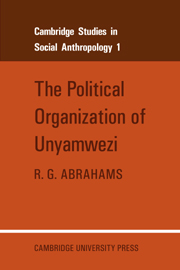Book contents
- Frontmatter
- Contents
- List of Tables
- List of Illustrations
- Foreword
- Preface
- Map of Unyamwezi
- 1 The People and their Country
- 2 The Historical Background
- 3 The External Situation
- 4 The Structure of the Chiefdom
- 5 The Business of Government
- 6 Mechanisms of Continuity
- 7 Rulers and Subjects
- 8 Neighbourhood and Politics
- 9 Conclusions
- Appendix A List of Chiefdoms in Unyamwezi
- Appendix B Nyamwezi Kinship Terminology
- Bibliography
- Index
4 - The Structure of the Chiefdom
Published online by Cambridge University Press: 11 November 2009
- Frontmatter
- Contents
- List of Tables
- List of Illustrations
- Foreword
- Preface
- Map of Unyamwezi
- 1 The People and their Country
- 2 The Historical Background
- 3 The External Situation
- 4 The Structure of the Chiefdom
- 5 The Business of Government
- 6 Mechanisms of Continuity
- 7 Rulers and Subjects
- 8 Neighbourhood and Politics
- 9 Conclusions
- Appendix A List of Chiefdoms in Unyamwezi
- Appendix B Nyamwezi Kinship Terminology
- Bibliography
- Index
Summary
Within the limits defined in the last chapter, Nyamwezi chiefdoms may be considered as a number of centralized states bounding on each other, and it is the modern structure of these states that I wish to describe in this chapter. In spite of this, some use of historical material will be necessary for a variety of reasons. The people themselves often justify present custom in terms of it having ‘been so in the past’, and, as we have seen, the policy of Indirect Rule presumes that the present political system is based on a traditional foundation. In addition, the importance of descent as a criterion of a person's eligibility to hold political office necessitates the use of genealogical evidence in any investigation of Nyamwezi political structure.
THE FRAMEWORK OF GOVERNMENT
The political organization of a Nyamwezi chiefdom is based upon a pyramidal hierarchy of territorial offices. Thus in Busangi chiefdom there is a chief who rules the whole chiefdom and under him there are four salaried headmen with administrative and judicial functions. Each of these salaried headmen is in charge of a territorial division which I call a village cluster, and the four divisions together cover the total area of the chiefdom. Each village cluster is composed of a number of villages in the charge of unsalaried headmen who are subordinate to the salaried headmen of the cluster. Two clusters, however, also contain a village which is administered directly by the salaried headmen.
- Type
- Chapter
- Information
- The Political Organization of Unyamwezi , pp. 62 - 98Publisher: Cambridge University PressPrint publication year: 1967

